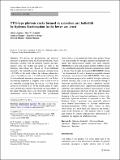| dc.contributor.author | Enggist, Andreas | |
| dc.contributor.author | Burg, Jean-Pierre | |
| dc.contributor.author | Hamid, Dawood | |
| dc.contributor.author | Hussain, Shahid | |
| dc.contributor.author | Schmidt, Max W. | |
| dc.contributor.author | Jagoutz, Oliver E | |
| dc.date.accessioned | 2016-11-21T19:35:14Z | |
| dc.date.available | 2016-11-21T19:35:14Z | |
| dc.date.issued | 2013-07 | |
| dc.date.submitted | 2012-06 | |
| dc.identifier.issn | 0010-7999 | |
| dc.identifier.issn | 1432-0967 | |
| dc.identifier.uri | http://hdl.handle.net/1721.1/105386 | |
| dc.description.abstract | We present the geochemistry and intrusion pressures of granitoids from the Kohistan batholith, which represents, together with the intruded volcanic and sedimentary units, the middle and upper arc crust of the Kohistan paleo-island arc. Based on Al-in-hornblende barometry, the batholith records intrusion pressures from ~0.2 GPa in the north (where the volcano-sedimentary cover is intruded) to max. ~0.9 GPa in the southeast. The Al-in-hornblende barometry demonstrates that the Kohistan batholith represents a complete cross section across an arc batholith, reaching from the top at ~8–9 km depth (north) to its bottom at 25–35 km (south-central to southeast). Despite the complete outcropping and accessibility of the entire batholith, there is no observable compositional stratification across the batholith. The geochemical characteristics of the granitoids define three groups. Group 1 is characterized by strongly enriched incompatible elements and unfractionated middle rare earth elements (MREE)/heavy rare earth element patterns (HREE); Group 2 has enriched incompatible element concentrations similar to Group 1 but strongly fractionated MREE/HREE. Group 3 is characterized by only a limited incompatible element enrichment and unfractionated MREE/HREE. The origin of the different groups can be modeled through a relatively hydrous (Group 1 and 2) and of a less hydrous (Group 3) fractional crystallization line from a primitive basaltic parent at different pressures. Appropriate mafic/ultramafic cumulates that explain the chemical characteristics of each group are preserved at the base of the arc. The Kohistan batholith strengthens the conclusion that hydrous fractionation is the most important mechanism to form volumetrically significant amounts of granitoids in arcs. The Kohistan Group 2 granitoids have essentially identical trace element characteristics as Archean tonalite–trondhjemite–granodiorite (TTG) suites. Based on these observations, it is most likely that similar to the Group 2 rocks in the Kohistan arc, TTG gneisses were to a large part formed by hydrous high-pressure differentiation of primitive arc magmas in subduction zones. | en_US |
| dc.description.sponsorship | National Science Foundation (U.S.) (Grant EAR 6920005) | en_US |
| dc.publisher | Springer Berlin Heidelberg | en_US |
| dc.relation.isversionof | http://dx.doi.org/10.1007/s00410-013-0911-4 | en_US |
| dc.rights | Creative Commons Attribution-Noncommercial-Share Alike | en_US |
| dc.rights.uri | http://creativecommons.org/licenses/by-nc-sa/4.0/ | en_US |
| dc.source | Springer Berlin Heidelberg | en_US |
| dc.title | TTG-type plutonic rocks formed in a modern arc batholith by hydrous fractionation in the lower arc crust | en_US |
| dc.type | Article | en_US |
| dc.identifier.citation | Jagoutz, Oliver et al. “TTG-Type Plutonic Rocks Formed in a Modern Arc Batholith by Hydrous Fractionation in the Lower Arc Crust.” Contributions to Mineralogy and Petrology 166.4 (2013): 1099–1118. | en_US |
| dc.contributor.department | Massachusetts Institute of Technology. Department of Earth, Atmospheric, and Planetary Sciences | en_US |
| dc.contributor.mitauthor | Jagoutz, Oliver E | |
| dc.relation.journal | Contributions to Mineralogy and Petrology | en_US |
| dc.eprint.version | Author's final manuscript | en_US |
| dc.type.uri | http://purl.org/eprint/type/JournalArticle | en_US |
| eprint.status | http://purl.org/eprint/status/PeerReviewed | en_US |
| dc.date.updated | 2016-08-18T15:26:37Z | |
| dc.language.rfc3066 | en | |
| dc.rights.holder | Springer-Verlag Berlin Heidelberg | |
| dspace.orderedauthors | Jagoutz, Oliver; Schmidt, Max W.; Enggist, Andreas; Burg, Jean-Pierre; Hamid, Dawood; Hussain, Shahid | en_US |
| dspace.embargo.terms | N | en |
| dc.identifier.orcid | https://orcid.org/0000-0003-2402-3736 | |
| mit.license | OPEN_ACCESS_POLICY | en_US |
